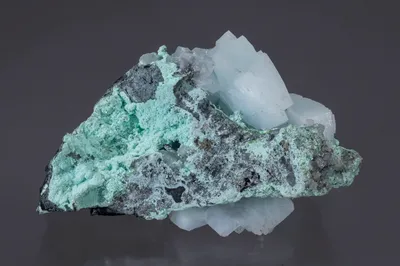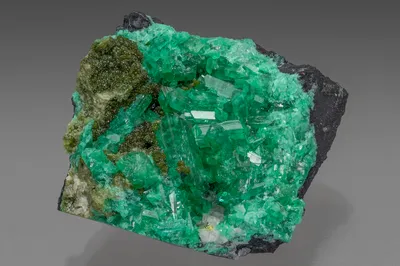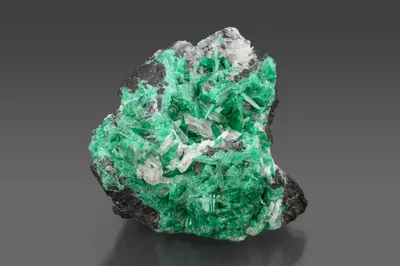
Image Credit: Jeff Scovil
Mineral Species
Schultenite
Type Locality
Yes
Composition
PbHAsO4
Crystal System
Monoclinic
Status at Tsumeb
Confirmed (type locality)
Abundance
Very rare
Distribution
First and second oxidation zones
Paragenesis
Supergene
Entry Number
Species; TSNB310
Type Mineralogy
In 1926 a specimen was acquired by the British Museum in London from Wilhelm Maucher of Munich, labelled as "Lanarkite: Tsumeb, Otavi, South-West Africa". In describing the specimen Spencer and Mountain (1926) wrote:
"Although the mineral was incorrectly labelled lanarkite, there can be no doubt about the locality, for the specimen is very typical of the pseudomorphous crusts that have been found in abundance at Tsumeb."
Analysis of the principal mineral on the specimen showed it to be a lead hydrogen arsenate, which Spencer (1926) named schultenite in honour of Baron A. de Schulten, who had synthesised the same compound some years earlier. Schultenite has grandfathered status (dated 1926) on the IMA list of minerals (http://cnmnc.units.it/; accessed January 2023). Claringbull (1950a) provided XRD data for schultenite and a more modern structural refinement was published by Effenberger and Pertlik (1986). The type specimen is conserved at the Natural History Museum, London (catalogue number BM.1926,205). A portion removed from the London holotype is in the Feinglos Collection at Harvard University (MGMH 2022.4.3083T).
General Notes
The schultenite type specimen probably originated from 7 Level in the first oxidation zone (Klein 1938), although this is neither specified by Spencer and Mountain (1926) nor evident from the labels accompanying the specimen or the catalogue entry at the NHM, London. According to Klein (1938), however, schultenite (mistaken at first for lanarkite) was found at a depth of 190 m [= 7 Level] and only in the eastern "stringers" (ausläufer). Klein stated that it occurred with anglesite and native sulphur and that it was very rare which is consistent with the observation that there are no entries for schultenite in the Klein Collection catalogue (unpublished; Klein family archive).
Spencer and Mountain (1926) described the type specimen as follows:
"The specimen shows a base of large (2 cm. across) crystals of yellowish anglesite which are altered on the surface and along cracks to bayldonite. Resting on the anglesite were tabular crystals probably of chessylite [= azurite], and hexagonal prisms and rods no doubt representing mimetite; both of these are now completely changed to bayldonite. The bayldonite (a basic arsenate of lead and copper) is yellowish-green in the interior, and bluish-green and minutely crystalline on the surface. The new mineral rests on these pseudomorphs, and is somewhat intermixed with bayldonite.
"The schultenite has the form of thin crystal plates which are perfectly transparent, clear, and colourless, and with a brilliant vitreous to almost adamantine lustre. The largest plates measure 1 cm. across with a thickness of 1 mm, and the smallest is about 1 mm across. The material is brittle and easily crushed to a white powder; hardness 2½."
A re-examination of the type specimen has shown that the "bayldonite" described by Spencer and Mountain (1926) is in fact thometzekite (Mike Rumsey, pers. comm. to M. Southwood, 2015). This was also the first confirmation of thometzekite in the first oxidation zone.
Spencer and Mountain (1926) described a second specimen in the NHM Collections (catalogue number BM.1922,338) also acquired from Wilhelm Maucher four years earlier and labelled "Anglesite pseudomorphous after a monoclinic mineral (lanarkite ? or gypsum ?)". They interpreted this specimen as a possible pseudomorph of anglesite after schultenite.
In the second oxidation zone, a discovery was made in 1975 comprising emerald-green zincolivenite associated with colourless schultenite and what would subsequently be described as keyite. Two specimens of this material were presented to the Natural History Museum, London by dealers Charles Key and Luis Texeira Leite (catalogue numbers BM.1975,399 and BM.1975,660; the latter is one of two keyite type specimens). These two specimens allowed Embrey and Hicks (1977) to provide a detailed description of the crystallography and physical properties of schultenite from the second oxidation zone. According to Gebhard (1999) and Von Bezing et al. (2014) this pocket was encountered on 28 Level.
The habit and association of these second oxidation zone schultenites is very different from the type material, occurring as "… rough cleaved prisms lying on the matrix and a complete but deeply etched crystal 13 x 13 x 8 mm too enclosed by cuproadamite [= zincolivenite] for examination" (Embrey and Hicks 1977). Pinch and Wilson (1977) described the material as "… superb crystals to 4 cm in length associated with cuproadamite, bayldonite, keyite and chalcocite; the crystals are clear and colorless with an appearance similar to gypsum."
Keller (1977a) placed schultenite in one of his "Type II" paragenetic sequences (i.e. minerals forming under acidic conditions):
II/4: primary sulphides >> conichalcite >> adamite [= zincolivenite] >> schultenite or chudobaite
Keller and Bartelke (1982) list schultenite among the many rare minerals found in the East 9 Pillar on 31 Level in the mid- to late 1970s. The extended paragenesis proposed by Keller and Bartelke (1982; page 145) for the East 9 Pillar assemblage shows schultenite as one of the last minerals to crystallise in this complex sequence of rare minerals.
In early 1980, the largest recorded schultenite crystal - 175 mm in length - was recovered from the North-East Stope on 35 Level (Keller and Bartelke 1982; citing a pers. comm. from John Innes). (Note that Von Bezing et al. (2014) suggested erroneously that this extraordinary crystal also came from the 28 Level discovery.)
Keller (1984) cautions that schultenite is readily confused with claudetite, gypsum or koritnigite.
Associated Minerals
anglesite; bayldonite; claudetite (?); gaitite; johillerite; keyite; koritnigite; mimetite; oxyplumbomoréite; prosperite; stranskiite; sulphur; tennantite-(Zn); thometzekite; wulfenite; zincolivenite
Pseudomorphs
The following minerals are reported to form pseudomorphs after schultenite: anglesite (rare, doubtful); arsentsumebite (rare, doubtful); goethite (rare).







